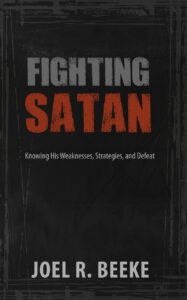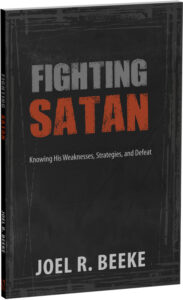
The doctrine of Satan developed further during the centuries between the testaments and in the New Testament. Intertestamental literature refers to Satan as Belial, Mastema, and Sammael. Satan is described as chief of an army of demons that wars against God and His angels. He tempts believers, attacks them, and leads devils and unregenerate people against God (Jub. 11:5; 17:16; 1 Enoch 40:7).
The intertestamental literature attributes evil in Old Testament times directly to Satan more often than the Old Testament does (Wisd. Sol. 2:24). The Old Testament usually doesn’t name Satan directly, but in the intertestamental writings Satan is explicitly described as “a fallen angel” (1 Enoch 29:4) who is in charge of the “fallen angels” spoken of in Genesis 6:1–4 (Jub. 10:5–8; 19:28).
Satan’s Names
We learn much more about Satan in the New Testament, which most often refers to Satan as “the devil” (diabolos). That term, which means “accuser” or “slanderer,” is used sixty times in the New Testament (KJV)—forty times in the Gospels alone. Satan is the preeminent slanderer. He slanders God to man, as with Eve; at times, he slanders man to God, as with Job; and he slanders man to man.
The term Satan occurs thirty-four times in the New Testament (KJV). Half of those terms are in the Gospels and Acts, and half in the Epistles and Revelation. All but six of the references refer to “the satan.” Other New Testament names for Satan include the accuser (Rev. 12:10); the adversary (1 Peter 5:8); Apollyon (Rev. 9:11); Beelzebub (Matt. 12:24); Belial (2 Cor. 6:15); the dragon (Rev. 12:7); the god of this world (2 Cor. 4:4); the prince of the power of the air (Eph. 2:2); the prince of this world (John 12:31); the serpent (Rev. 20:2); and the tempter (Matt. 4:3).
How diverse and powerful these names reveal Satan to be! One Puritan, Edward Reynolds, put it this way, “Three names Satan hath given him from his three most active principles: a ‘serpent,’ for his cunning (Gen. 3:1); a ‘lion,’ for his strength (1 Peter 5:8); and a ‘dragon,’ for his malice (Rev. 20:2).”6
Satan’s Personality, Army, and Subjects
These names teach us that Satan is not an impersonal evil force. He possesses all the traits of personality, such as intellect (2 Cor. 11:3); emotion (Rev. 12:17); and will (2 Tim. 2:26). Personal pronouns are also used of him (Matt. 4:1–12). Being a person, he is held morally accountable by the Lord (Matt. 25:41). That’s why the New Testament speaks of him as proud, rebellious, lawless, and slanderous and calls him a liar, a deceiver, a distorter, and an imitator.
The New Testament reveals Satan as the ruler of a host of fallen angels (Matt. 25:41) and as the head of a well-organized army of spiritual agents. Terms such as principalities, powers, and rulers of the darkness of this world indicate ranks in Satan’s army (Eph. 6:12). By means of these ranks of demons, Satan, like a competent general, gathers his information and carries out his program throughout his worldwide kingdom of darkness.
Satan and his demons carry out their evil, devilish activity among people in the world who do not acknowledge Christ as Lord (Mark 4:15; John 8:44; Col. 1:13). With temptations ranging from asceticism to libertinism and from mere intellectual theism (without heart conviction) to crass occultism, he blinds their minds, seeks to prevent their believing in Christ alone for salvation, and strives to retain their allegiance to himself (2 Cor. 4:4; Luke 8:12, respectively). That is why his human followers are called “the children of the wicked one” (Matt. 13:38); his “ministers” (2 Cor. 11:15); and “the children of the devil” (1 John 3:10).
Demon Possession
In some cases Satan and his demons enter into and control their followers so fully that they engage in demon possession. Luke 8:30 describes a man whose name was Legion because “many devils were entered into him.” Particularly prior to Christ’s death and resurrection, Satan and his demons were permitted to exert dreadful, powerful, overt attacks upon some people’s minds and bodies. God permitted that power, in part, so that people might deeply know their need for a deliverer, and that the power of Christ to deliver them would be prominently displayed. Demon possessions could produce blindness (Matt. 12:22); paralysis (Acts 8:7); convulsions (Luke 9:39); paroxysms (Mark 9:17, 20, 26); self-destruction (Mark 9:22); superhuman strength (Mark 5:4); personality splits (Mark 5:6–10); special knowledge to identify Jesus (Mark 5:7); and insanity and bizarre behavior (Matt. 17:15; Luke 8:27), showing that there is no kind of affliction, mental or physical, that Satan and his demons are unwilling to bring upon people. Common to all these is destructiveness, for Satan is ever the destroyer. In most cases, the gospel authors are careful to differentiate demonic activity from various physical sicknesses (Matt. 4:24; Luke 4:40–41).
Satan is bitterly opposed to God and seeks to alienate everyone from Him; hence he also wages intense war against the followers of Christ (Luke 8:33; 1 Cor. 7:5). Since every believer is indwelt by the Holy Spirit and belongs to Jesus, no believer can be demon possessed (1 Cor. 6:19). John affirms this by saying that Jesus, who is in us, is greater than Satan, who is in the world (1 John 4:4). Nevertheless, Satan still so influenced Peter’s thinking that Jesus had to say firmly to the disciple, “Get thee behind me, Satan!” (Matt. 16:23). Luke 22:31 tells us that Satan wanted to sift all the disciples as wheat to test them. Revelation 12:10 says that Satan seeks to accuse believers before God.
Satan versus Christ
The conflict between the devil and the Seed of the woman took the center stage with the incarnation of the Word. The coming of Jesus Christ in the fullness of time was God’s greatest move against Satan in spiritual warfare. Jesus spoke more about Satan and demons than anyone else in the Bible. Satan and his demons unleashed their strongest fury against Jesus, whose sinless humanity motivated Satan to tempt Him in special ways. In the desert of Judea, Christ stepped from the water of baptism into the fire of temptation. For forty days, Satan attacked Jesus in the lusts of the flesh, the lusts of the eyes, and the boastful pride of life, trying to get Christ’s sacred humanity under his control (Matt. 4:1–11). Satan tempted Jesus to independence (4:3–4); indulgence (4:5–7); and idolatry (4:8–10). His underlying goal was to make Christ’s substitution unnecessary by offering Christ glory without the cross, just as he had promised glory to Eve without obedience to God.
Jesus held His ground, repeatedly driving away Satan and his demons from Himself and, subsequently, from other people in His public ministry. He engaged in a ministry of proclaiming deliverance to the captives (Luke 4:18). In His confrontation with the Pharisees over the healing of a demonpossessed man who was blind and mute, Jesus made clear His intent to drive Satan out of people’s lives (Matt. 12:26). Jesus also liberated a woman whom Satan had kept bound for eighteen years (Luke 13:16).
In Gethsemane, Satan unleashed all the powers of hell. Even while the cup of God’s wrath brought Jesus to His knees, Satan directed one of Christ’s apostles to betray Him and sifted Christ’s best friends like wheat, so that all forsook Him (Luke 22:3, 31; John 13:2, 27; Matt. 26:56, respectively). How this must have broken Christ’s heart (Ps. 69:20)! What bruising of the soul Christ experienced at the hands of Satan’s instrument, Judas Iscariot! No wonder He said to the satanic forces, “This is your hour, and the power of darkness” (Luke 22:53).
The satanic attack continued at Gabbatha, where Christ was forced to wear a purple robe and a crown of thorns while he was scourged, mocked, slapped, and bruised. Finally, at Golgotha, Satan unleashed all the forces of evil once more. The bulls of Bashan encompassed the suffering Messiah (Ps. 22:12). Every insult was heaped on Jesus; the brutal solders, the cruel spectators, and the selfish priests and elders in their holy robes of office engaged in satanic mocking while Christ hung on the cross in the naked flame of His Father’s wrath, rejected by heaven, earth, and hell. His unfathomable cry of agony rang through the dark realm of nature, “My God, my God, why hast thou forsaken me?” (Matt. 27:46).
Luther once spent an entire morning trying to comprehend this agony, only to rise from his knees confessing, “God forsaken of God; who can understand it?”7 Indeed, that truth is incomprehensible. But this much we know: Satan was defeated on the cross, once and for all. Hebrews 2:14 says, “Through death he [that is, Christ] might destroy him that had the power of death, that is, the devil.” The victory belongs to Christ because of His perfect obedience throughout the most severe tests instigated by Satan.
Through His life, death, resurrection, and ascension, Christ singlehandedly broke the power of the oppressor. Satan lost his suffocating rule over the nations. The balance of power was turned. In the Old Testament era, flashes of light appeared in the darkness. But now, in and through Christ, the light has dawned. Christ’s abiding light and glory now outweigh Satan’s remaining evil and darkness.
After Christ’s resurrection and ascension into heaven, demon possession greatly diminished. The book of Acts reports a few instances that generally occurred when the gospel was first brought to an area. Peter and Philip both cast out demons on at least one occasion (Acts 5:16; 8:7). Paul delivered a young woman from a fortune-telling demon at Philippi and cast out demons at Ephesus (Acts 16:16–18; 19:11–12). But the New Testament epistles make no mention of demon possession and give no instructions for exorcism. Demon possession does not seem to have been a problem in the New Testament church.
Satan versus the New Testament Church
Satan, however, did not easily admit defeat. He continued to bruise the heel of Christ’s church in other ways. The New Testament church found victory in Christ only through the same kind of suffering and bruising that the Savior experienced. Acts tells us how Satan brought trouble into the church by persuading Ananias and Sapphira to disrupt the church’s peace with a lie (Acts 5:3). Satan tempted Corinthian church members to abandon selfcontrol in sexual matters (1 Cor. 7:5). He tempted Paul by inflicting on him “a thorn in the flesh” (2 Cor. 12:7) and by preventing him from traveling to Thessalonica (1 Thess. 2:18). He persecuted believers in Smyrna (Rev. 2:9– 10) and deceived the nations of the earth (Rev. 20:7–8), disguising himself as an angel of light to accomplish his purposes (2 Cor. 11:14). His demons serve as agents of apostasy (1 Tim. 4:1–3) and as promoters of the man of lawlessness and the spirit of antichrist (2 Thess. 2:9; Rev. 2:18–29; 9:1–11).
Throughout all of Satan’s opposition, the church pressed on. Despite temporary setbacks, the gates of hell did not prevail against her, for Jesus is mightier than Satan.
Excerpt from
Fighting Satan: Knowing His Weaknesses, Strategies, and Defeat
By Joel Beeke










